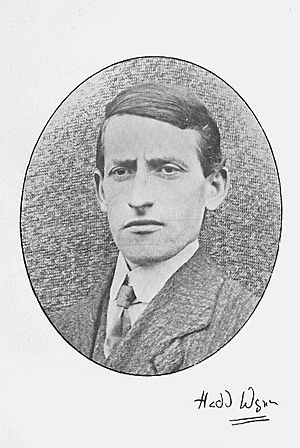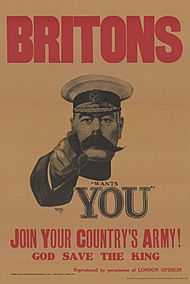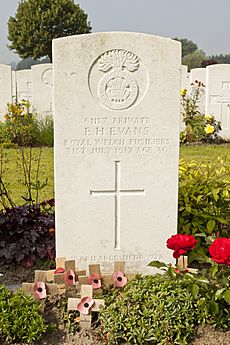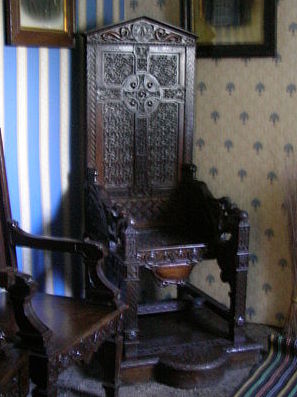Hedd Wyn facts for kids
Quick facts for kids
Hedd Wyn
|
|
|---|---|

Ellis Humphrey Evans, c.1910.
Frontispiece in Cerddi'r Bugail (1918) |
|
| Born | Ellis Humphrey Evans 13 January 1887 Yr Ysgwrn Trawsfynydd, Merionethshire, Wales |
| Died | 31 July 1917 (aged 30) Pilckem Ridge, Passchendaele salient, Belgium |
| Resting place | Artillery Wood Cemetery, Boezinge, Belgium |
| Pen name | Hedd wyn, Fleur De Lys |
| Occupation | Poet Shepherd/farmer soldier |
| Language | Welsh |
| Citizenship | Welsh |
| Period | 1800–1900 |
| Genre | Welsh Poetry |
| Literary movement | Romantic and war poetry |
| Notable works | Yr Arwr, Ystrad Fflur, Plant Trawsfynydd, Y Blotyn Du, Nid â’n Ango, Rhyfel |
| Notable awards | Bard's chair at the 1917 National Eisteddfod |
Hedd Wyn (born Ellis Humphrey Evans, January 13, 1887 – July 31, 1917) was a famous Welsh-language poet. He was killed during World War I on the first day of the Battle of Passchendaele. After his death, he was given the top poetry award, the bard's chair, at the 1917 National Eisteddfod.
Ellis Evans had won many poetry awards before. He chose the name Hedd Wyn (which means "blessed peace") because of how sunlight looked through the mist in the Meirionnydd valleys. He was born in Trawsfynydd, Wales. He wrote most of his poems while working as a shepherd on his family's farm. His poems were often about nature and religion. He also wrote several war poems after the war started in 1914.
Contents
Early Life of Hedd Wyn
Ellis Humphrey Evans was born on January 13, 1887. His birthplace was Penlan, a house in the village of Trawsfynydd, Wales. He was the oldest of eleven children. In 1887, his family moved to Yr Ysgwrn, his father's 168-acre farm. This farm was a few miles from Trawsfynydd. Ellis lived there for most of his life.
Ellis went to primary school and Sunday school from age six. He left school around age fourteen. After that, he worked as a shepherd on his father's farm. Even with little formal schooling, he was a talented poet. He wrote his first poem, "Y Das Fawn" (the peat stack), when he was only eleven. Ellis loved both Welsh and English poetry. He was greatly inspired by the Romantic poetry of Percy Bysshe Shelley. His poems often focused on nature and religion.
Poetry Competitions: Eisteddfodau
Ellis Evans's poetry talent was well known in his village. He took part in many local competitions called eisteddfodau. He won his first "chair" (Cadair y Bardd) in Bala in 1907, when he was 20. In 1910, a poet named Bryfdir gave him the special name Hedd Wyn. This happened at a meeting for poets in Blaenau Ffestiniog. 'Hedd' means peace in Welsh, and 'Wyn' can mean white or pure. This "blessed peace" also referred to how sunlight shone through the misty valleys.
Bryfdir was the special name for Ellis's older friend, Humphrey Jones. Humphrey Jones was a quarry worker from Blaenau Ffestiniog. He published two books of poetry and won over 60 bardic chairs. He said he gave Ellis the name Hedd Wyn because Ellis seemed like a calm dreamer. Another close friend of Hedd Wyn was the writer R. Silyn Roberts.
In 1913, Hedd Wyn, at 26, became more famous for his poetry. He won chairs at local eisteddfodau in Pwllheli and Llanuwchllyn. In 1915, he won again in Pontardawe and Llanuwchllyn. That same year, he entered his poem Eryri (about Snowdonia) into the National Eisteddfod of Wales. The next year, he came in second place at the National Eisteddfod in Aberystwyth. His poem was Ystrad Fflur, about the old Cistercian abbey ruins in Ceredigion.
Hedd Wyn and World War I
Hedd Wyn was a Christian pacifist. This means he believed war was wrong and did not want to fight. He felt he could never kill anyone. The war caused big disagreements among Welsh non-conformists. These groups traditionally did not like the idea of war. But during WWI, some supported fighting, while others stuck to their peaceful religious beliefs.
The war greatly influenced Hedd Wyn's writing. It led to some of his most famous poems. These include Plant Trawsfynydd ("Children of Trawsfynydd") and Y Blotyn Du ("The Black Dot"). His poem, Rhyfel ("War"), is still one of his most quoted works.
|
Gwae fi fy myw mewn oes mor ddreng, |
Why must I live in this grim age, |
Joining the Army
Farm work was important for the country. So, farmers were usually not forced to join the army. But in 1916, the Evans family had to send one son to the British Army. Ellis, who was 29, joined instead of his younger brother Robert. In February 1917, he trained at Litherland Camp in Liverpool.
In March 1917, the government needed farm workers for ploughing. Many soldiers were allowed to go home temporarily. Hedd Wyn got seven weeks of leave. He spent most of this time working on his long poem, Yr Arwr ("The Hero"). This poem was for the National Eisteddfod. His nephew, Gerald Williams, later shared a story about this time. He said it was a very wet year in 1917. Hedd Wyn came home for two weeks and wrote the poem. Because of the rain, he stayed an extra seven days. This extra time made him a deserter. The military police came to get him from the hayfield. They took him to jail in Blaenau Ffestiniog. From there, he went to the war in Belgium. He left so quickly that he forgot his poem. So, he wrote it again during his journey. Now, there are two copies of the poem.
In June 1917, Hedd Wyn joined the 15th Battalion Royal Welsh Fusiliers. This group was part of the 38th (Welsh) Division. They were in Fléchin, France. He felt very sad when he arrived there. He said, "Heavy weather, heavy soul, heavy heart. That is an uncomfortable trinity, isn’t it?" Still, in Fléchin, he finished his poem for the National Eisteddfod. He signed it “Fleur de Lis”. It was sent by mail around the end of June. On July 31, the 15th Battalion marched towards a big attack. This attack became known as the Battle of Passchendaele.
The Third Battle of Ypres and His Death
Hedd Wyn was badly wounded within hours of the Third Battle of Ypres starting. This was on July 31, 1917. He fell during the Battle of Pilckem Ridge. This battle began at 3:50 a.m. with heavy bombing of the German lines. But the soldiers' advance was difficult. They faced enemy artillery and machine gun fire. Heavy rain also turned the battlefield into a swamp.
Private Evans was part of the 15th (Service) Battalion. He was moving towards a German strongpoint. This was in the ruins of a Belgian village called Hagebos. That is when he was hit. In 1975, a veteran named Simon Jones shared his memory. He said, "We started over Canal Bank at Ypres. He was killed half way across Pilckem. I saw him fall. It was a shell that hit his stomach. He was going in front of me. I saw him fall to his knees and grab two fistfuls of dirt. He was dying, of course."
Soon after being wounded, Hedd Wyn was taken to a first-aid station. He was still awake. He asked the doctor, "Do you think I will live?" But it was clear he would not survive. He died around 11:00 a.m. that day. Another poet, Francis Ledwidge, also died that day. He was an Irish war poet.
Ellis H. Evans was buried in Section II, Row F, Grave 11. This is at Artillery Wood Cemetery, near Boezinge. After the war, people asked for a special message on his headstone. So, the words Y Prifardd Hedd Wyn (English: "The Chief Bard, Hedd Wyn") were added.
Hedd Wyn's Legacy
The National Eisteddfod of the Black Chair
On September 6, 1917, the Chairing of the Bard ceremony took place. It was at the National Eisteddfod in Birkenhead Park, England. The British Prime Minister, David Lloyd George, who spoke Welsh, was there. The judges announced that the poem signed Fleur de Lys was the winner. Trumpets were played for the author to come forward. After three calls, the leader of the poets, Archdruid Dyfed, sadly announced the winner had been killed in action six weeks earlier.
The empty chair was then covered with a black sheet. It was sent to Hedd Wyn's parents in the same way. Archdruid Dyfed said, "the festival in tears and the poet in his grave." This festival is now known as "Eisteddfod y Gadair Ddu" ("The Eisteddfod of the Black Chair").
A craftsman from Flemish named Eugeen Vanfleteren made the chair by hand. He was a carpenter from Mechelen, Belgium. He had moved to England when the war started.
His Writings and Books
Right after the Eisteddfod, a group was formed in Trawsfynydd. Their goal was to protect Hedd Wyn's writings. Led by J. R. Jones, the village school head teacher, they collected all his handwritten poems. These were carefully kept safe. Because of their work, the first collection of his poems was published in 1918. It was called Cerddi'r Bugail ("The Shepherd's Poems"). His original writings were given to the National Library of Wales in 1934.
A complete collection of his Welsh poems, Hedd Wyn, Ei Farddoniaeth, was published in 2012.
The poem Yr Arwr ("The Hero") is still seen as Hedd Wyn's greatest work. This is the poem that won him the National Eisteddfod. It has four parts and features two main characters. They are Merch y Drycinoedd ("Daughter of the Tempests") and the Arwr (Hero). People have had different ideas about what the poem means. But it is clear that Hedd Wyn, like his favorite poet Shelley, hoped for a perfect world during the war.
Merch y Drycinoedd is often seen as a symbol of love and nature's beauty. Yr Arwr represents goodness, fairness, and freedom. The poem suggests that through the hero's sacrifice, a better time will come.
Trawsfynydd and Yr Ysgwrn Farm
A bronze statue of Hedd Wyn was put up in his home village of Trawsfynydd in 1923. He is shown dressed as a shepherd. On the statue, there is a short poem he wrote for a friend who died, Tommy Morris.
|
Ei aberth nid â heibio – ei wyneb |
His sacrifice was not in vain, his face |
Hedd Wyn's bardic chair is always on display at his family's farm, Yr Ysgwrn. His family kept the farm just as it was in 1917. His nephew, Gerald Williams (who passed away in 2021), was the last relative to live there. For many years, Gerald and his brother Ellis farmed the land. They also welcomed visitors and worked hard to keep Hedd Wyn's story alive. In 2012, Gerald decided to pass the care of Yr Ysgwrn to the Snowdonia National Park Authority.
The Park Authority, with help from the Welsh Government and the National Lottery, bought the farm in 2012. It is a Grade II-listed farmstead. Their goal is to protect the site and make it better for visitors. This way, more people can learn Hedd Wyn's story. In the same year, Gerald Williams received an MBE award. This was for his "exceptional contribution" to saving his uncle's history.
100-Year Anniversaries
In August 2014, the Welsh Memorial Park, Ypres was opened. It is near Pilckem Ridge in Ypres. This war memorial is close to where Hedd Wyn was badly wounded in July 1917.
To mark 100 years since his death, a new Bardic chair was made. It celebrated Hedd Wyn's life. It was given to the Welsh Government at a special service in Birkenhead Park in September 2017. A memorial for the poet was also put in the park.
In November 2017, a video about Hedd Wyn was shown on the outside walls of the National Library of Wales. This was part of the yearly British Armistice commemorations. This video project involved over 800 schoolchildren and adults across Wales. They learned about the poet's life and what he left behind.





